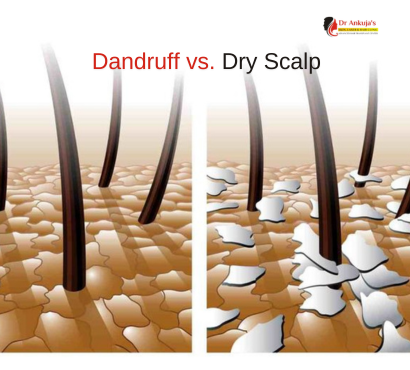Dandruff and dry scalp are among the most common scalp issues in India. Both cause flakes and itching—but they’re not the same. Understanding their differences is crucial for effective treatment and long-term scalp health. Let’s break down how to spot each one, explore what causes them, and reveal the best solutions for an itch-free, healthy scalp.
The Science: What’s the Real Difference?
Dry Scalp
- Main Cause: Lack of moisture/oil in the scalp.
- Flakes: Small, dry, powdery white flakes—often finer and lighter than dandruff.
- Itch/Feel: Tightness, irritation, mild to intense itching, often made worse after shampooing or during cold/dry weather.
- Scalp/Hair: Hair is often dry, brittle, and prone to breakage. Scalp itself may look dull or ashy.
- Other Clues: People with dry scalp often have dry skin on other body parts, especially in winter.
Dandruff
- Main Cause: Excess oil on scalp leads to overgrowth of Malassezia yeast (fungus). The fungus breaks down oil, producing irritants such as oleic acid that trigger inflammation and scaling.
- Flakes: Larger, sticky, oily, yellow-white flakes that often cluster together and cling to strands or clothing.
- Itch/Feel: Persistent and severe itching, sometimes redness and mild swelling. Scalp may appear greasy.
- Scalp/Hair: Hair can look limp, oily, and heavy. Scalp may show greasy patches.
- Other Clues: If you often see oily, clumped flakes even soon after shampooing, dandruff is likely.
Table: Key Differences at a Glance
| Feature | Dry Scalp | Dandruff |
| Flake appearance | Small, white, powdery | Large, oily, yellowish, clumped |
| Hair feel | Dry, brittle, frizzy | Greasy, limp, can be flat |
| Scalp look | Dull, may be ashy, no redness | Oily, red, mild swelling possible |
| Trigger | Dry/cold weather, harsh shampoo | Excess oil, stress, hormone, yeast/fungus |
| Common in | Dry skin types | Oily or combination scalp |
| Skin elsewhere | Usually dry | Normal or even oily elsewhere |
| Other symptoms | Tightness, mild itching | Persistent itching, redness |
Causes: Why Do These Happen?
Dry Scalp Causes
- Over-washing or harsh shampoos
- Frequent use of heat styling tools
- Dry/cold climates or air conditioning
- Unbalanced diets low in healthy fats
- Certain medical conditions (eczema, hypothyroidism, psoriasis)
Dandruff Causes
- Seborrheic dermatitis (mild form)
- Overproduction of sebum (scalp oil)
- Overgrowth of Malassezia yeast
- Hormonal changes or stress
- Harsh hair products aggravating oil imbalance
- Lack of vitamin D, immune changes
How to Tell Which One You Have: At-Home Self-Test
- Observe the flakes: Are they small, fine, and white (likely dry scalp)? Or large, oily, sticky, and yellowish (likely dandruff)?
- Assess hair/scalp: Is your hair dry and frizzy, or oily and flat? Does your scalp feel tight, or greasy and itchy?
- Season/pattern: Worsens in winter (dry scalp), or all year long (dandruff)?
- Try this quick test: Apply a gentle moisturiser/coconut oil overnight. If flakes reduce by next day, it’s probably dry scalp. If not, suspect dandruff.
If you have persistent, painful, or worsening symptoms, consult a dermatologist as some scalp conditions (psoriasis, seborrheic dermatitis, fungal infections) can mimic both issues.
Solution Strategies: Dry Scalp vs. Dandruff Treatment
For Dry Scalp
- Use sulfate-free, nourishing shampoos. Reduce frequency of washing.
- Moisturize scalp: coconut oil, aloe vera, jojoba oil mask before shampooing.
- Avoid hot water and heat-styling tools.
- Drink plenty of water and include healthy fats in diet (nuts, seeds, olive oil).
- Use a humidifier in dry weather.
- Avoid harsh hair dyes, gels, and sprays.
- Home care: Banana, yogurt, or avocado masks for extra hydration.
For Dandruff
- Use anti-dandruff shampoos with ketoconazole, zinc pyrithione, selenium sulfide, coal tar, or salicylic acid. Rotate formulas if needed.
- Massage scalp and let shampoo sit for 2–5 minutes before rinsing.
- Tea tree oil or apple cider vinegar rinse (diluted) may help as natural antifungals.
- Regular washing to control oil production. Avoid occlusive headgear/hats when possible.
- Reduce sugar, refined carbs, and processed foods—promote scalp health with fresh, whole foods.
- Manage stress and consider vitamin D supplementation if deficient.
- If no improvement after 2–3 weeks, or severe symptoms: consult a doctor. You might need prescription treatments or be checked for seborrheic dermatitis/psoriasis.
Indian Context: Climate, Habits, and Diet
- Seasonal variation: Winter/dry weather increases dry scalp, while monsoon humidity can worsen dandruff.
- Hair oiling: Weekly oiling is a common home remedy—but avoid heavy oils for dandruff (may worsen fungus) and focus on lighter oils for dry scalp.
- Diet: Traditional Indian diets, rich in omega-3 (from nuts, seeds, fish) and antioxidants, can help restore scalp balance.
- Pollution: Urban air can dry the scalp or increase oiliness—cover hair with a scarf when outside in cities.
FAQ
- Can you have both dandruff and dry scalp at the same time?
Yes, especially in India’s mixed climate or after using harsh shampoos that strip oil, leading to dryness even if fungal dandruff is present. Treat gently, balancing antifungal and moisturizing care. - When should I visit a doctor for scalp flaking and itching?
If symptoms persist beyond 2–3 weeks of home care, are painful, intensely itchy, spreading, or associated with hair loss, redness, swelling, or sores—seek a dermatologist’s advice. These may signal another skin/scalp condition. - Are natural remedies like coconut oil, aloe vera, and tea tree oil safe for all?
Generally, yes for mild, non-allergic individuals, but do a patch test to be sure. Don’t use essential oils undiluted and always follow up with gentle washing. For severe or recurrent cases, medical products may be needed.

